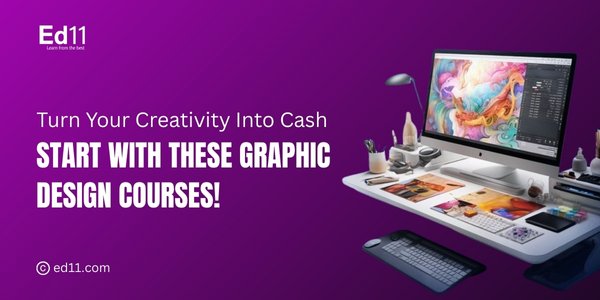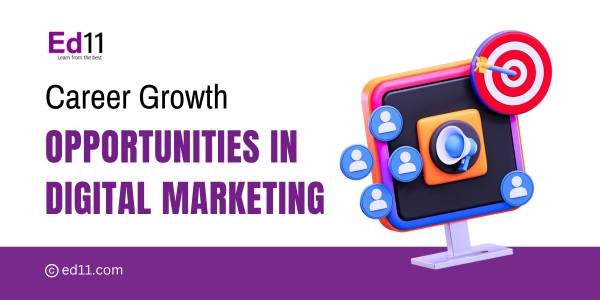Graphic Design Courses to Kickstart Your Career
Learn graphic design from basic to advanced skills. Join online graphic design courses and start your creative career with expert guidance.

In our daily lives, graphic design is everywhere, from product packaging to social media posts, advertisements, and even magazine layouts. If you have a passion for creativity and visual storytelling, a graphic design course could be your gateway to an exciting career. Throughout my career as a graphic design specialist, I've been asked many questions about how I got started. And what guidance would I offer to people who are just beginning? Graphic design is a skill set that combines art with technology, strategy, and communication, not just creativity. Graphic design courses helped me get started in my career. Graphic design courses are essential for anyone wishing to enter this sector, not just an option. These courses offer the framework, direction, and knowledge of technology you need to become a true master of design, irrespective of your level of experience. Selecting the Best Graphic Design Courses Can Change Your Life.
Why Choose Graphic Design as a Career?
Graphic design is not just about making things look pretty. It’s about problem-solving, creating effective communication, and evoking emotions through visual elements. Every brand, website, advertisement, and social media post is a designer's effort. The need for talented designers who can tell stories and deliver messages through images has grown as a result of the development of digital media. Graphic design is important for branding, product design, marketing, and much more. An excellent graphic design makes a company stand out and connect with customers. Career options in graphic design courses are wide-ranging and numerous. From beginning your own business to working for digital marketing and advertising organizations.
How Do Graphic Design Courses Help Build Skills?
-
Hands-On Learning: Numerous graphic design courses provide real-world, hands-on training. Working on actual projects, you'll develop a resume that demonstrates your technical skills and creativity. Applying theoretical principles to actual designs gives you a feel for what it’s like to work in the industry.
-
Guidance from Experts: Graphic design courses not only teach you technical skills but also give you access to industry specialists who can offer advice and comments. Their observations can assist you in enhancing your work, understanding current trends, and handling the competitive field of design. Gaining access to their expertise and experience can provide you with a major advantage when advancing in your profession.
-
Portfolio Development: A key tool for any graphic designer is a strong portfolio. You'll build a portfolio through graphic design courses that demonstrates your problem-solving and visual communication skills. Making a strong portfolio is essential for designers because it is how employers and clients evaluate them most of the time.
-
Mastering Software Tools: Graphic designers need specialized software. The majority of graphic design courses will teach you how to use the Adobe Creative Suite and other common software. Being skilled with these tools enables you to produce designs of a professional caliber, and most design positions frequently demand it.
Types of Graphic Design Courses
Graphic design courses will be available in a variety of forms that address a variety of requirements and skill levels. While some courses concentrate on more advanced subjects, others are designed for beginners.
-
Beginner Courses: If you’re new to graphic design, beginner-level graphic design courses will introduce you to the fundamentals. These courses focus on basic design principles, color theory, typography, and basic software skills. They’re designed to give you a strong foundation before moving on to more complex topics.
-
Advanced Courses: Graphic design courses dive deeper into specialized areas like UI/UX design, branding, motion graphics, and web design. These courses often involve more complex projects and provide opportunities to experiment with various design styles.
-
Online vs. in-person courses: The flexibility of online graphic design courses makes them a popular choice for many learners. You can study at your place and access learning materials anytime, anywhere. In-person courses, on the other hand, offer more interaction with instructors and classmates, which can be beneficial for those who thrive in a more structured environment.
Benefits of Learning Graphic Design
Graphic design is more than just making things look good — it’s a powerful skill with creative, professional, and personal benefits. Here are some key advantages of learning graphic design.
-
High-Demand Career Opportunities: Graphic design is one of the most in-demand skills in the digital world. Almost every business, brand, or organization needs graphic design services to create visual content that connects with their audience. From social media graphics to website layouts, advertising banners to brand logos — the demand for skilled designers is growing rapidly in various industries.
-
Freelancing & Remote Work: One of the biggest benefits of learning graphic design is the opportunity to work as a freelancer or remote designer. Unlike traditional jobs that require you to work in a fixed location or office, graphic design gives you the freedom to work from anywhere, whether it's from home, a co-working space, or even while traveling.
-
Enhances Creativity & Innovation: Learning graphic design plays a vital role in improving creativity and innovation. Graphic design is not just about creating attractive visuals; it’s about thinking creatively to solve problems and communicate ideas effectively. It encourages you to think outside the box and explore new ways of expressing messages through colors, shapes, typography, and layouts.
-
Strong Earning Potential: Graphic design offers strong earning potential for skilled and creative professionals. As the demand for visual content continues to grow across industries, businesses are willing to pay well for high-quality design work. Whether you are working as a full-time designer in a company or offering freelance services, graphic design can provide excellent income opportunities.
-
Personal Branding Power: Graphic design skills allow you to create your own logo, business cards, social media graphics, website design, and marketing materials. Instead of depending on others, you can design your brand identity according to your personality, style, and goals. This helps in building a professional and consistent image across online and offline platforms.
Skills You Will Learn in Graphic Design Courses
Graphic design courses are designed to develop both technical and creative skills that are essential for becoming a successful designer. These skills not only help in creating visually appealing designs but also enhance your problem-solving and communication abilities. Here are the key skills you will learn in a graphic design course.
-
Design Principles: Design principles are the basic guidelines that every graphic designer must follow to create visually appealing and effective designs. These principles help in organizing different elements like text, images, shapes, and colors in a proper structure to communicate the intended message clearly. Some of the important design principles include balance, contrast, alignment, hierarchy, and proportion.
-
Typography Skills: Typography is one of the most important skills you will learn in graphic design. It is the art of arranging text in a visually appealing and readable way. In graphic design, typography is not just about selecting a font; it’s about using text creatively to convey a message and enhance the overall design.
-
Color Theory & Usage: Color theory is an essential skill in graphic design that helps designers understand how to use colors effectively in their creations. Colors play a powerful role in attracting attention, creating emotions, and communicating messages visually. In graphic design courses, you will learn how to apply color theory to create visually balanced and appealing designs.
-
Software Skills: Software skills are one of the most important parts of learning graphic design. Graphic design courses provide training on various professional design software tools that help in creating creative and high-quality designs. These tools are widely used in the industry for designing logos, posters, brochures, advertisements, social media graphics, websites, and much more.
-
Logo & Branding Design: Logo and branding design is a crucial skill that you will learn in graphic design courses. A logo is the visual identity of a company, product, or service, and it plays a key role in brand recognition. Branding design involves creating a complete visual identity that represents the values, vision, and personality of a business.
Career Opportunities After Completing Graphic Design Courses
A universe of opportunities welcomes you once your graphic design courses are finished. With your additional abilities, you can choose to work in a variety of fields.
-
Advertising and Marketing: Designers are essential in creating advertisements and marketing materials that grab attention and communicate messages effectively.
-
Web and App Design: As a web designer, you’ll create visually appealing and user-friendly websites and apps. This role requires a good understanding of both graphic design and user experience principles.
-
Branding and Identity Design: Companies need designers to help develop their brand’s identity. This involves designing logos, packaging, and other elements that define a brand's image.
-
Freelancing: Many graphic designers choose to work as freelancers. This gives you the flexibility to work with various clients and on diverse projects, allowing you to build a portfolio that reflects your range of skills.
-
Motion Graphics and Animation: Designers with a passion for animation can work in the motion graphics industry, creating animated videos for ads, entertainment, and instructional content.
Tips to Succeed in Graphic Design
-
Build a strong portfolio: Your portfolio showcases your skills to potential clients and employers.
-
Stay Updated with Trends: Follow design blogs and social media to keep up with industry changes.
-
Network with Other Designers: Connect with professionals and participate in design communities.
-
Practice Regularly: The more you design, the better you become. Take on personal projects to refine your skills.
It can be exciting and hard to begin a career in graphic design, but the appropriate courses can make all the difference. You may develop the abilities and self-assurance necessary to produce eye-catching graphics and assemble a solid portfolio by signing up for a course. Graphic design courses can provide you with the skills and information you need to thrive in the quick-paced design industry, regardless of whether your goal is to work for an agency, launch your own company, or work for yourself. More than just a job, graphic design is an art form that enables you to solve issues, convey ideas graphically, and have an impact on both individuals and companies. Thus, now is the perfect moment to investigate career options if you have a strong creative side and wish to pursue that side of your love.


















